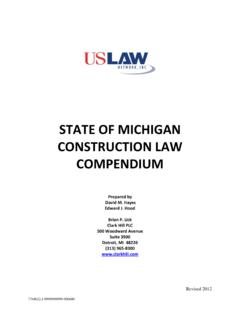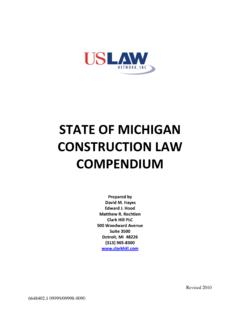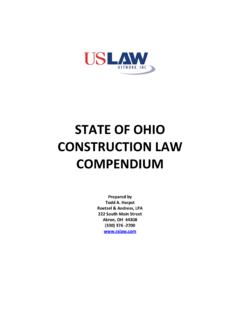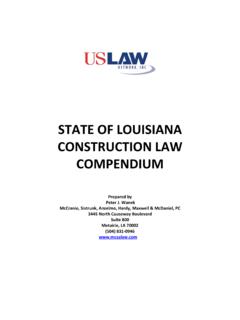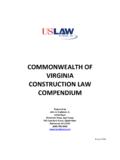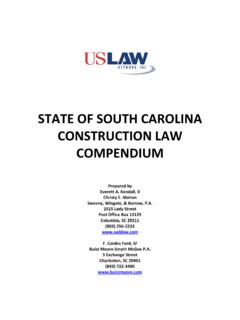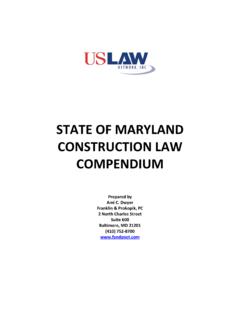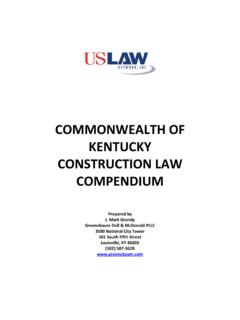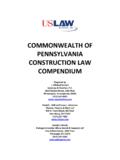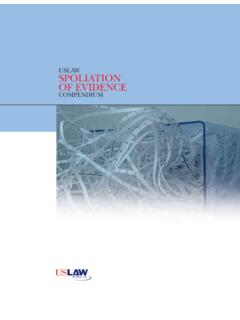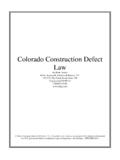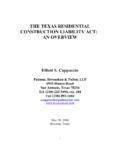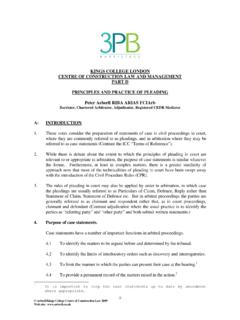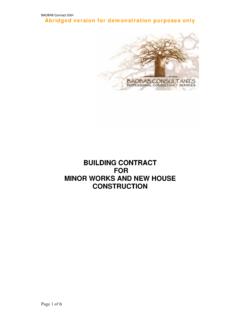Transcription of STATE OF CALIFORNIA CONSTRUCTION LAW …
1 Revised 2012 STATE OF CALIFORNIA CONSTRUCTION LAW COMPENDIUM Prepared by Andrea L. Fellion Rodrigo E. Salas Dillingham & Murphy, LLP 225 Bush Street Sixth Floor San Francisco, CA 94104 (415) 397-2700 Jean A. Dalmore Daniel G. Pezold Murchison & Cumming, LLP 801 South Grand Avenue Ninth Floor Los Angeles, CA 90017 (213) 623-7400 2 Revised 2012 I. INTRODUCTION CALIFORNIA CONSTRUCTION defect litigation is, by and large, governed by two statutory schemes. The first, the Right to Repair Act (Cal. Civil Code, 896 ), came into effect on January 1, 2003, and is commonly referred by its legislative bill, SB 800. The Act defines what constitutes a CONSTRUCTION defect in CALIFORNIA by establishing functionality standards, the violation of which is actionable as a matter of law.
2 The Right to Repair Act applies to original CONSTRUCTION intended to be sold as an individual residence where the purchase agreement is signed on or after January 1, 2003. The second statutory scheme, the Davis-Stirling Common Interest Development Act (Cal. Civil Code, ), is commonly referred to as the Calderon Procedures and applies to common interest developments such as apartment complexes and Homeowner s Association claimants. These procedures require prefiling dispute resolution process between homeowners associations and common interest development builders (general contractors, all subcontractors, design professionals, and insurers of all potentially liable parties).
3 II. ACTIONABLE CLAIMS IN CONSTRUCTION DEFECT LITIGATION A. Strict Liability Under the strict liability doctrine, CONSTRUCTION defect plaintiffs may recover damages without having to prove breach of duty. Rather, they need only show that a mass-produced consumer item is defective and that the defect proximately caused injuries. Del Mar Beach Club v. Imperial Contracting Co., (1981) 123 898. The Right to Repair Act sets forth about 45 functionality standards, a violation of each constitutes an actionable claim. The standards are divided into seven categories: (1) water intrusion issues, (2) structural issues, (3) soil issues, (4) fire protection issues, (5) plumbing and sewer issues, (6) electrical system issues, and (7) a catch-all category regarding other areas of CONSTRUCTION .
4 If the violation of a standard causes damage to a manufactured product, or if the manufactured product causes damage to other building components, those damages are recoverable under Cal. Civil Code 896(g)(3)(D). Potential strict liability defendants in CONSTRUCTION defect cases include builders of mass-produced homes, developers of building sites, manufacturers of component parts, material suppliers, and, in some circumstances, subcontractors. B. Negligence Where an injury occurs due to negligent CONSTRUCTION of a residence, a negligence cause of action may lie. Proof of negligence in the CONSTRUCTION defect context requires that plaintiff demonstrate that the defendant fell below established professional standards or failed to meet building code requirements.
5 As such, the standard of care required in the CONSTRUCTION of a home must, in most cases, be established by expert testimony. Miller v. Los Angeles County Flood Control Dis. (1973) 8 689, 703. 3 Revised 2012 In 2000, the CALIFORNIA Supreme Court held that there could be no cause of action for negligence against a developer, contractor or subcontractor without some proof of consequential damage. Aas v. Superior Court (2000) 24 627. Pursuant to Aas, a CONSTRUCTION defect plaintiff could not sue a builder for a defect unless there had been actual bodily injury or damage to property. The Right to Repair Act expressly superseded Aas by allowing claims where there is no resultant or consequential damage other than the defect itself.
6 As discussed above, however, these causes of action are based on statutory strict liability. C. Breach Of Warranty A warranty is a contractual term concerning some aspect of the sale, such as title to the goods, or their quality or quantity. The warranty may be express or implied. Breach of Express Warranties - Contracts involving real property often contain warranties regarding conditions of the property. An express warranty is an affirmation of fact or promise made by the seller to a buyer that relates to the items sold and becomes part of the basis of the bargain. See Cal. Uniform Comm. Code 2313. A seller s obligation to a buyer for breach of warranty is one of strict liability.
7 Basin Oil Co. v. Baash-Ross Tool Co., (1954) 125 578, 596 (where a breach of warranty is established, liability is imposed entirely independent of the question of negligence on the part of the seller). Breach of Implied Warranties Implied warranties are based on implied representations rather than promises and may be created by statute or case law. CALIFORNIA courts have long maintained that builder and seller of new CONSTRUCTION are bound by an implied warranty that the completed structure was designed and constructed in a reasonably workmanlike manner. Windham At Carmel v. Mountain Ranch (2003) 109 1162; see also Pollard v. Saxe & Yolles Dev t. Co., (1974) 12 374, 380.
8 Because of the new CONSTRUCTION component, it has been held that privity of contract must exist between the plaintiff and the original builder or seller before a cause of action for breach of implied warranty may be sustained. However, stringent privity is not an express requirement for enforcement of the CALIFORNIA Civil Code 900 fit and finish warranty. Traditionally, the doctrine of implied warranty has not been applied to design professionals, , architects and engineers. D. Breach Of Contract The written purchase agreement of the sale of a home generally contains a number of provisions that may give rise to a breach of contract cause of action. A breach of contract action may also arise from breach of a design contract.
9 Bayuk v. Edsun (1965) 236 309. As indicated above, causes of action for breach of express warranties are routinely asserted in CONSTRUCTION defect litigation. In addition, contracts between developer, contractor and subcontractor may also give rise to breach of contract actions and, as explained below, form the basis for indemnity claims and cross-claims. Breach of contract causes of action seeking redress for injury to real property have been recognized in CALIFORNIA . In those cases the accrual of the breach of contract action is governed by the discovery rule. Angeles Chemical Co. v. Spencer & Jones (1996) 44 112, 119- 4 Revised 2012 120 (the accrual of plaintiff s cause of action is postponed until plaintiff either (1) actually discovers his injury and its negligent cause, or (2) could have discovered injury and cause through the exercise of reasonable diligence.)
10 The statutes include a limitation of 4 years for breach of written agreement, 3 years for damage to real property, and 2 years for personal injury caused by breach of contract CONSTRUCTION defect. Emotional distress damages are not recoverable under breach of contract theory where breach did not cause physical injury and the alleged emotional distress arose solely from property damage. Erlich v. Menendez (1999) 21 543; see also Cal. Civil Code 3300, 3301, 3333. E. Misrepresentation And Fraud Intentional misrepresentation about CONSTRUCTION defects and nondisclosure about such defects are actionable as damage claims. In CALIFORNIA , the essential elements of a cause of action by intentional misrepresentation are: (1) the defendant made a representation as to a past or existing material fact, (2) the representation was false, (3) the defendant must have known that the representation was false when made (or must have made the representation recklessly without knowing whether it was true or false), (4) the defendant made the representation with an intent to defraud the plaintiff, (5) plaintiff was unaware of the falsity of the representation and must have acted in reliance therein, and (6) as a result of the reliance, plaintiff sustained damage.
